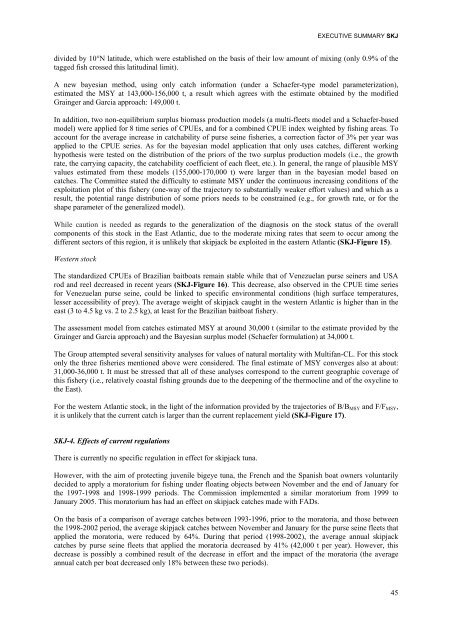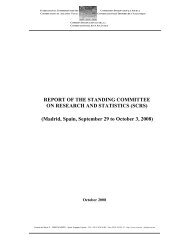REPORT OF THE STANDING COMMITTEE ON RESEARCH ... - Iccat
REPORT OF THE STANDING COMMITTEE ON RESEARCH ... - Iccat
REPORT OF THE STANDING COMMITTEE ON RESEARCH ... - Iccat
Create successful ePaper yourself
Turn your PDF publications into a flip-book with our unique Google optimized e-Paper software.
EXECUTIVE SUMMARY SKJ<br />
divided by 10°N latitude, which were established on the basis of their low amount of mixing (only 0.9% of the<br />
tagged fish crossed this latitudinal limit).<br />
A new bayesian method, using only catch information (under a Schaefer-type model parameterization),<br />
estimated the MSY at 143,000-156,000 t, a result which agrees with the estimate obtained by the modified<br />
Grainger and Garcia approach: 149,000 t.<br />
In addition, two non-equilibrium surplus biomass production models (a multi-fleets model and a Schaefer-based<br />
model) were applied for 8 time series of CPUEs, and for a combined CPUE index weighted by fishing areas. To<br />
account for the average increase in catchability of purse seine fisheries, a correction factor of 3% per year was<br />
applied to the CPUE series. As for the bayesian model application that only uses catches, different working<br />
hypothesis were tested on the distribution of the priors of the two surplus production models (i.e., the growth<br />
rate, the carrying capacity, the catchability coefficient of each fleet, etc.). In general, the range of plausible MSY<br />
values estimated from these models (155,000-170,000 t) were larger than in the bayesian model based on<br />
catches. The Committee stated the difficulty to estimate MSY under the continuous increasing conditions of the<br />
exploitation plot of this fishery (one-way of the trajectory to substantially weaker effort values) and which as a<br />
result, the potential range distribution of some priors needs to be constrained (e.g., for growth rate, or for the<br />
shape parameter of the generalized model).<br />
While caution is needed as regards to the generalization of the diagnosis on the stock status of the overall<br />
components of this stock in the East Atlantic, due to the moderate mixing rates that seem to occur among the<br />
different sectors of this region, it is unlikely that skipjack be exploited in the eastern Atlantic (SKJ-Figure 15).<br />
Western stock<br />
The standardized CPUEs of Brazilian baitboats remain stable while that of Venezuelan purse seiners and USA<br />
rod and reel decreased in recent years (SKJ-Figure 16). This decrease, also observed in the CPUE time series<br />
for Venezuelan purse seine, could be linked to specific environmental conditions (high surface temperatures,<br />
lesser accessibility of prey). The average weight of skipjack caught in the western Atlantic is higher than in the<br />
east (3 to 4.5 kg vs. 2 to 2.5 kg), at least for the Brazilian baitboat fishery.<br />
The assessment model from catches estimated MSY at around 30,000 t (similar to the estimate provided by the<br />
Grainger and Garcia approach) and the Bayesian surplus model (Schaefer formulation) at 34,000 t.<br />
The Group attempted several sensitivity analyses for values of natural mortality with Multifan-CL. For this stock<br />
only the three fisheries mentioned above were considered. The final estimate of MSY converges also at about:<br />
31,000-36,000 t. It must be stressed that all of these analyses correspond to the current geographic coverage of<br />
this fishery (i.e., relatively coastal fishing grounds due to the deepening of the thermocline and of the oxycline to<br />
the East).<br />
For the western Atlantic stock, in the light of the information provided by the trajectories of B/B MSY and F/F MSY ,<br />
it is unlikely that the current catch is larger than the current replacement yield (SKJ-Figure 17).<br />
SKJ-4. Effects of current regulations<br />
There is currently no specific regulation in effect for skipjack tuna.<br />
However, with the aim of protecting juvenile bigeye tuna, the French and the Spanish boat owners voluntarily<br />
decided to apply a moratorium for fishing under floating objects between November and the end of January for<br />
the 1997-1998 and 1998-1999 periods. The Commission implemented a similar moratorium from 1999 to<br />
January 2005. This moratorium has had an effect on skipjack catches made with FADs.<br />
On the basis of a comparison of average catches between 1993-1996, prior to the moratoria, and those between<br />
the 1998-2002 period, the average skipjack catches between November and January for the purse seine fleets that<br />
applied the moratoria, were reduced by 64%. During that period (1998-2002), the average annual skipjack<br />
catches by purse seine fleets that applied the moratoria decreased by 41% (42,000 t per year). However, this<br />
decrease is possibly a combined result of the decrease in effort and the impact of the moratoria (the average<br />
annual catch per boat decreased only 18% between these two periods).<br />
45

















